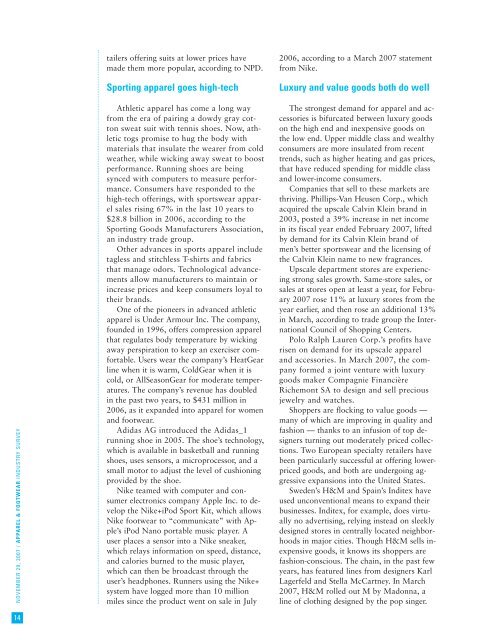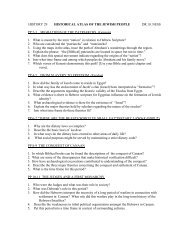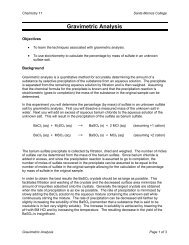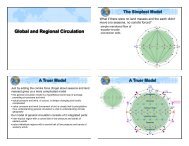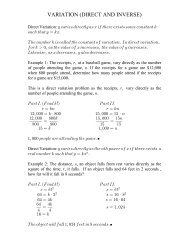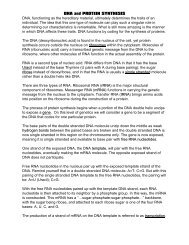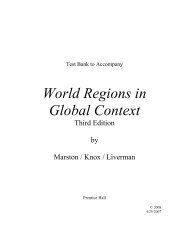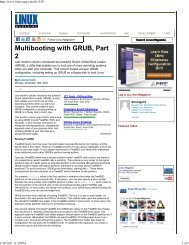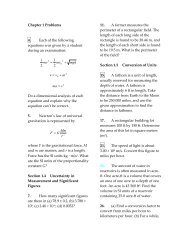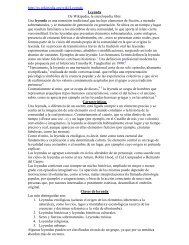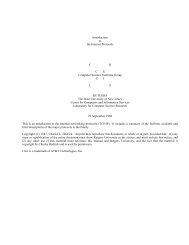You also want an ePaper? Increase the reach of your titles
YUMPU automatically turns print PDFs into web optimized ePapers that Google loves.
NOVEMBER 29, 2007 / APPAREL & FOOTWEAR INDUSTRY SURVEY<br />
14<br />
tailers offering suits at lower prices have<br />
made them more popular, according to NPD.<br />
Sporting apparel goes high-tech<br />
Athletic apparel has come a long way<br />
from the era of pairing a dowdy gray cotton<br />
sweat suit with tennis shoes. Now, athletic<br />
togs promise to hug the body with<br />
materials that insulate the wearer from cold<br />
weather, while wicking away sweat to boost<br />
performance. Running shoes are being<br />
synced with computers to measure performance.<br />
Consumers have responded to the<br />
high-tech offerings, with sportswear apparel<br />
sales rising 67% in the last 10 years to<br />
$28.8 billion in 2006, according to the<br />
Sporting Goods Manufacturers Association,<br />
an industry trade group.<br />
Other advances in sports apparel include<br />
tagless and stitchless T-shirts and fabrics<br />
that manage odors. Technological advancements<br />
allow manufacturers to maintain or<br />
increase prices and keep consumers loyal to<br />
their brands.<br />
One of the pioneers in advanced athletic<br />
apparel is Under Armour Inc. The company,<br />
founded in 1996, offers compression apparel<br />
that regulates body temperature by wicking<br />
away perspiration to keep an exerciser comfortable.<br />
Users wear the company’s HeatGear<br />
line when it is warm, ColdGear when it is<br />
cold, or AllSeasonGear for moderate temperatures.<br />
The company’s revenue has doubled<br />
in the past two years, to $431 million in<br />
2006, as it expanded into apparel for women<br />
and footwear.<br />
Adidas AG introduced the Adidas_1<br />
running shoe in 2005. The shoe’s technology,<br />
which is available in basketball and running<br />
shoes, uses sensors, a microprocessor, and a<br />
small motor to adjust the level of cushioning<br />
provided by the shoe.<br />
Nike teamed with computer and consumer<br />
electronics company Apple Inc. to develop<br />
the Nike+iPod Sport Kit, which allows<br />
Nike footwear to “communicate” with Apple’s<br />
iPod Nano portable music player. A<br />
user places a sensor into a Nike sneaker,<br />
which relays information on speed, distance,<br />
and calories burned to the music player,<br />
which can then be broadcast through the<br />
user’s headphones. Runners using the Nike+<br />
system have logged more than 10 million<br />
miles since the product went on sale in July<br />
2006, according to a March 2007 statement<br />
from Nike.<br />
Luxury and value goods both do well<br />
The strongest demand for apparel and accessories<br />
is bifurcated between luxury goods<br />
on the high end and inexpensive goods on<br />
the low end. Upper middle class and wealthy<br />
consumers are more insulated from recent<br />
trends, such as higher heating and gas prices,<br />
that have reduced spending for middle class<br />
and lower-income consumers.<br />
Companies that sell to these markets are<br />
thriving. Phillips-Van Heusen Corp., which<br />
acquired the upscale Calvin Klein brand in<br />
2003, posted a 39% increase in net income<br />
in its fiscal year ended February 2007, lifted<br />
by demand for its Calvin Klein brand of<br />
men’s better sportswear and the licensing of<br />
the Calvin Klein name to new fragrances.<br />
Upscale department stores are experiencing<br />
strong sales growth. Same-store sales, or<br />
sales at stores open at least a year, for February<br />
2007 rose 11% at luxury stores from the<br />
year earlier, and then rose an additional 13%<br />
in March, according to trade group the International<br />
Council of Shopping Centers.<br />
Polo Ralph Lauren Corp.’s profits have<br />
risen on demand for its upscale apparel<br />
and accessories. In March 2007, the company<br />
formed a joint venture with luxury<br />
goods maker Compagnie Financière<br />
Richemont SA to design and sell precious<br />
jewelry and watches.<br />
Shoppers are flocking to value goods —<br />
many of which are improving in quality and<br />
fashion — thanks to an infusion of top designers<br />
turning out moderately priced collections.<br />
Two European specialty retailers have<br />
been particularly successful at offering lowerpriced<br />
goods, and both are undergoing aggressive<br />
expansions into the United States.<br />
Sweden’s H&M and Spain’s Inditex have<br />
used unconventional means to expand their<br />
businesses. Inditex, for example, does virtually<br />
no advertising, relying instead on sleekly<br />
designed stores in centrally located neighborhoods<br />
in major cities. Though H&M sells inexpensive<br />
goods, it knows its shoppers are<br />
fashion-conscious. The chain, in the past few<br />
years, has featured lines from designers Karl<br />
Lagerfeld and Stella McCartney. In March<br />
2007, H&M rolled out M by Madonna, a<br />
line of clothing designed by the pop singer.


